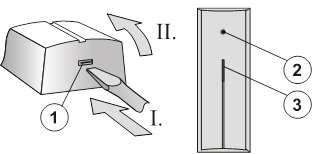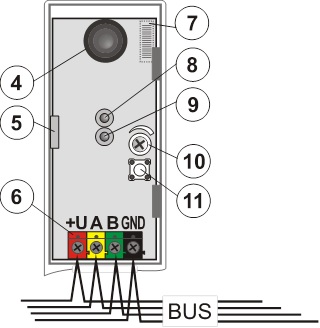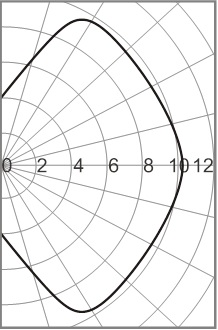Service note for JA-110B Wired glass breakage detector This product is a component of the JABLOTRON JA-100 alarm system. It serves to detect the breaking of glass panels, which are part of the shell of the building to be protected. It reacts to air pressure change, which is accompanied by...
JA-110B
Too much choice? Chat or call us at 085-0160316
There are no products in these categories. Shop on.

Service note for JA-110B
Wired glass breakage detector
This product is a component of the JABLOTRON JA-100 alarm system. It serves to detect the breaking of glass panels, which are part of the shell of the building to be protected. It reacts to air pressure change, which is accompanied by the characteristic sound of glass breakage. The detector has an impulse response (it only reports its own activation). The product is intended to be installed by a trained technician with a valid Jablotron certificate.
Installation
The detector is mounted in interior areas. In the room to be monitored, there must be no sound/noise sources, no vibrating devices and/or moving objects that create a pressure wave. We also advise against mounting the detector in areas where air flows (ventilation, air conditioning, draft holes, non-closing doors, etc.). In front of the detector, there must be no sound-absorbing objects (e.g. thick curtains).

Figure: 1 - hood snap clip; 2 - sensor; 3 - activation and malfunction signal lights;
1. Open the cover by pressing the snap clip (1)
2. Remove the electronics plate - by releasing the snap clip (5).
3. Pull the cables through the plastic back panel and screw them in place at the selected location.
For connecting the BUS, the system must be disconnected from the power supply.
4. Replace the electronics and connect the bus cable to the terminals (6).
5. Continue to follow the installation instructions for the central unit. Basic steps:
a. After switching on, the yellow signal light (9) flashes because the detector is not assigned to the system.
b. In the F-Link programme on the peripheral devices map, select the desired position and start learning mode with the Read button.
c. Press the tamper switch in the detector (11) - this will make the detector learn and the yellow signal light will go out.
6. Close the detector cover and check that the rubber part of the sensor (4) does not cover the hole in the cover.

Afbeelding: 4 - sensor; 5 - click terminal of electronics; 6 - terminals for the bus; 7 - bar code (placed from below); 8 - red signal light of detector activation; 9 - yellow signal light of malfunction; 10 - sensitivity setting; 11 - tamper switch;
Detector testing and setting
Stroke consecutively with a suitable tool or by hand in protective glove against all glass surfaces in the monitored area (the glass should not break, only deform). The detector reacts to the deformation of the glass (change of pressure in the room) by briefly flashing the red signal light. The reaction may come only after a clear blow against the glass.
Sensitivity to pressure changes can be set with the trimmer (10). A sensitivity set too high may result in false alarms.
Complex detector operation can be checked by the GBT-212 test, which generates the sound of breaking glass after a blow against the glass. In this case, the red signal light of the detector (8) lights up for 3 sec.
Turn off the signal light
This is done by the F-Link programme - card Peripherals. At the position of the detector, select Internal settings. A dialogue appears, in which the signal light of the detector activation (8) can be switched off.
Detection characteristic

Figure: Detection characteristic of the detector.
Technical parameters
Power supply from the BUS of the central unit 12 V (9 ... 15 V)
Current consumption for standby (idle) 5 mA
Current consumption for cable selection 5 mA
Recommended installation height 2.5 m above the floor
Detection distance up to 9 m
Minimum area of the glass panel 0.6 x 0.6 m
Period of stabilisation after power-on: max. 60 s
Dimensions 40 x 100 x 22 mm
Classification grade 2
compliant with CSN EN 50131-1, CSN CLC/TS 50131-2-7-1
Environments compliant with CSN EN 50131-1 II. indoor, general
Range of operating temperatures -10 to +40 °C
Further complies with CSN EN 50130-4, CSN EN 55022
Installation
The detector is mounted in interior areas. In the room to be monitored, there must be no sound/noise sources, no vibrating devices and/or moving objects that create a pressure wave. We also advise against mounting the detector in areas where air flows (ventilation, air conditioning, draft holes, non-closing doors, etc.). In front of the detector, there must be no sound-absorbing objects (e.g. thick curtains).

Figure: 1 - hood snap clip; 2 - sensor; 3 - activation and malfunction signal lights;
1. Open the cover by pressing the snap clip (1)
2. Remove the electronics plate - by releasing the snap clip (5).
3. Pull the cables through the plastic back panel and screw them in place at the selected location.
For connecting the BUS, the system must be disconnected from the power supply.
4. Replace the electronics and connect the bus cable to the terminals (6).
5. Continue to follow the installation instructions for the central unit. Basic steps:
a. After switching on, the yellow signal light (9) flashes because the detector is not assigned to the system.
b. In the F-Link programme on the peripheral devices map, select the desired position and start learning mode with the Read button.
c. Press the tamper switch in the detector (11) - this will make the detector learn and the yellow signal light will go out.
6. Close the detector cover and check that the rubber part of the sensor (4) does not cover the hole in the cover.

Afbeelding: 4 - sensor; 5 - click terminal of electronics; 6 - terminals for the bus; 7 - bar code (placed from below); 8 - red signal light of detector activation; 9 - yellow signal light of malfunction; 10 - sensitivity setting; 11 - tamper switch;
Detector testing and setting
Stroke consecutively with a suitable tool or by hand in protective glove against all glass surfaces in the monitored area (the glass should not break, only deform). The detector reacts to the deformation of the glass (change of pressure in the room) by briefly flashing the red signal light. The reaction may come only after a clear blow against the glass.
Sensitivity to pressure changes can be set with the trimmer (10). A sensitivity set too high may result in false alarms.
Complex detector operation can be checked by the GBT-212 test, which generates the sound of breaking glass after a blow against the glass. In this case, the red signal light of the detector (8) lights up for 3 sec.
Turn off the signal light
This is done by the F-Link programme - card Peripherals. At the position of the detector, select Internal settings. A dialogue appears, in which the signal light of the detector activation (8) can be switched off.
Detection characteristic

Figure: Detection characteristic of the detector.
Technical parameters
Power supply from the BUS of the central unit 12 V (9 ... 15 V)
Current consumption for standby (idle) 5 mA
Current consumption for cable selection 5 mA
Recommended installation height 2.5 m above the floor
Detection distance up to 9 m
Minimum area of the glass panel 0.6 x 0.6 m
Period of stabilisation after power-on: max. 60 s
Dimensions 40 x 100 x 22 mm
Classification grade 2
compliant with CSN EN 50131-1, CSN CLC/TS 50131-2-7-1
Environments compliant with CSN EN 50131-1 II. indoor, general
Range of operating temperatures -10 to +40 °C
Further complies with CSN EN 50130-4, CSN EN 55022
